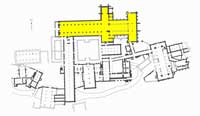 |
 |
 |
 |
 |
 |
 |
|
Fountains Abbey: History
Fountains Abbey: Buildings
|
The church stood at the heart of Cistercian life and brought together communal worship, private prayer, ceremony and ritual. The church building physically dominated the precinct and structured the monks’ day, for the community visited the church at least eight times daily to celebrate the Divine Office. Like all Cistercian churches, the abbey church at Fountains was dedicated to the Virgin Mary, the patron of the Order.
An exciting and significant discovery was made at Fountains in 1979-80, when excavations in the south transept uncovered the post pits of a timber church beneath the site of the present ruins. These remains belonged to the first church at Fountains, which was built in the 1130s under the direction of Geoffrey of Clairvaux. This early wooden structure served the community while building in stone was underway. It is extremely rare to find evidence of these early wooden buildings, and this remarkable find at Fountains has contributed greatly to our understanding of the nature and process of building here and elsewhere. In fact, the only other evidence for a wooden Cistercian church in England is from Bordesley Abbey, Worcestershire, where timber from the first church was used to cover early burials in the cemetery.(3) |
